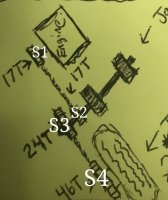79josh81
XS650 Addict
Ok, so I’m working out the details on some sprocket gearing to potentially run a jackshaft with a wide tire build. On my current bike, I have a 17 tooth front sprocket and a 31 tooth rear overdrive sprocket. The gearing ratio of that combination is 1.82.
I would like the bike I’m building to have around the same gear ratio but I’ll be using a Harley style wheel on the rear with a Harley 46 tooth rear sprocket. In order to get around the same gear ratio, according to the numbers, the front sprocket would have to be a 24 tooth sprocket which would give me a gear ratio of 1.91.
My question is, if I run a chain from the 17 tooth front sprocket to a 17 tooth sprocket on the jackshaft, and then run a 24 tooth sprocket on the jackshaft going to the 46 tooth rear tire sprocket, will that give me a gear ratio of 1.91 to the rear tire? It sounds right in my head but I’m not an engineer so I don’t know if I’m missing something here. Here’s a “not to scale” pic to make it easier to understand.

I would like the bike I’m building to have around the same gear ratio but I’ll be using a Harley style wheel on the rear with a Harley 46 tooth rear sprocket. In order to get around the same gear ratio, according to the numbers, the front sprocket would have to be a 24 tooth sprocket which would give me a gear ratio of 1.91.
My question is, if I run a chain from the 17 tooth front sprocket to a 17 tooth sprocket on the jackshaft, and then run a 24 tooth sprocket on the jackshaft going to the 46 tooth rear tire sprocket, will that give me a gear ratio of 1.91 to the rear tire? It sounds right in my head but I’m not an engineer so I don’t know if I’m missing something here. Here’s a “not to scale” pic to make it easier to understand.


